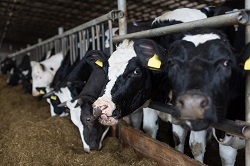How re-using food waste for animal feed cuts carbon emissions
Food waste is a topic that often reaches the headlines. Around 100 million tonnes of food is wasted in the EU every year – a figure which could rise to 120 million tonnes by 2020. Food waste has economic, environmental and even ethical dimensions, and it’s something the EU is keen to tackle. The EU-funded NOSHAN project has taken a step in this direction by researching ways to channel food waste into animal feed. The project found that replacing 10 % of the ingredients in animal feed with ingredients derived from food waste has a positive impact on the sustainability of the feed production chain. ‘Our results demonstrated that with a NOSHAN 10 % mix diet, for every kilogram of broiler chicken feed, carbon dioxide emissions were reduced by 0.3 kg compared to a non-food waste diet,’ explains Montse Jorba, NOSHAN project coordinator. ‘If 1 % of total chicken broiler feed in Europe was switched to the 10 % NOSHAN mix diet, the total amount of CO2 emissions avoided would be 0.62 million tonnes each year.’ Feed containing food waste would also decrease the amount of raw materials such as soybeans used for piglet and broiler chicken diets, cutting the EU’s import bill. The EU imports 20 million tonnes of soybeans each year – the majority of which is used for animal feed. ‘Furthermore, NOSHAN showed that using food waste could reduce the amount of land dedicated to producing animal feed and cut ecotoxicity by eliminating the need for chemical fertilisers and pesticides on this land,’ says Jorba. NOSHAN explored waste generated at all stages of the food chain – from agriculture to consumption. A selection of waste was made according to its nutritional properties, seasonality, safety, regulatory issues and logistics. The project then carried out field trials of its diet on animals. The bulk waste ingredients successfully tested were rapeseed press cake, yogurt and whey powder. The nutritional additives were pectic oligosaccharides from sugar beet pulp, peptides from rapeseed press cake and olive pomace extract – the by-product of olive pressing. ‘We demonstrated that using ingredients from by-products maintains the health and welfare of the animals. Some food by-products, such as olive pomace can actually improve gut health in pigs and poultry,’ explains Jorba. NOSHAN also explored the food safety aspect by testing the feed mix at all stages of its use. To limit the development of pathogens, the project used innovative technologies including drying techniques, dewatering of dairy waste and mechanical pressing of fruit, vegetable and plant waste. NOSHAN developed an open access database of European food by-products and waste. The database contains information on the different waste sources that can be used in animal feed ingredients as well as in other applications. With the project now over, NOSHAN hopes to carry out the next level of research on ways to commercialise these ingredients and bring innovative new technologies to the market. For more information please see NOSHAN project website
Countries
Spain



